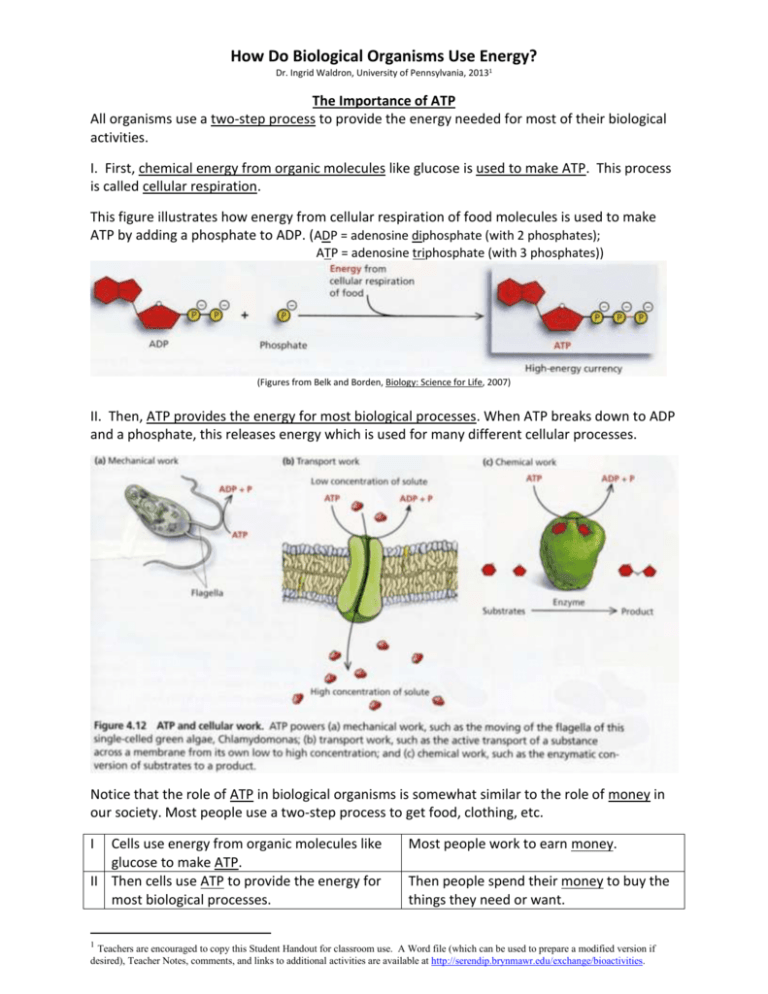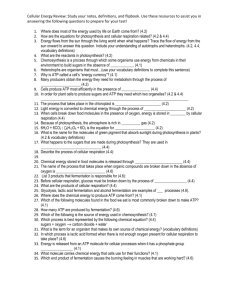How Biological Organisms Use Energy
advertisement

How Do Biological Organisms Use Energy? Dr. Ingrid Waldron, University of Pennsylvania, 20131 The Importance of ATP All organisms use a two-step process to provide the energy needed for most of their biological activities. I. First, chemical energy from organic molecules like glucose is used to make ATP. This process is called cellular respiration. This figure illustrates how energy from cellular respiration of food molecules is used to make ATP by adding a phosphate to ADP. (ADP = adenosine diphosphate (with 2 phosphates); ATP = adenosine triphosphate (with 3 phosphates)) (Figures from Belk and Borden, Biology: Science for Life, 2007) II. Then, ATP provides the energy for most biological processes. When ATP breaks down to ADP and a phosphate, this releases energy which is used for many different cellular processes. Notice that the role of ATP in biological organisms is somewhat similar to the role of money in our society. Most people use a two-step process to get food, clothing, etc. I Cells use energy from organic molecules like glucose to make ATP. II Then cells use ATP to provide the energy for most biological processes. 1 Most people work to earn money. Then people spend their money to buy the things they need or want. Teachers are encouraged to copy this Student Handout for classroom use. A Word file (which can be used to prepare a modified version if desired), Teacher Notes, comments, and links to additional activities are available at http://serendip.brynmawr.edu/exchange/bioactivities. 1. Explain why the reaction, ADP + phosphate ATP, requires energy input. (Hint: Review the top figure on the previous page and remember that like charges repel each other.) 2. Explain why the cells in all biological organisms need to carry out the reaction, ATP ADP + phosphate. How is this reaction useful? I. Using Energy from Organic Molecules to Make ATP – Cellular Respiration Cellular respiration is the process that transfers some of the chemical energy in glucose or another organic molecule to chemical energy in ATP molecules. Cellular respiration is a complex process with many steps. This diagram gives a simplified overview of the cellular respiration of glucose to produce ATP. C6 H12O6 + 6 O2 ---> ---> ---> 6 CO2 + 6 H2O \/ \/ \/ energy \/ up to 29 ADP + phosphate ---------> up to 29 ATP 3a. Write in the names of each of the molecules in the first equation shown above. 3b. All types of energy conversion are inefficient and result in the production of heat. For example, only about 30% of the energy released by cellular respiration of a glucose molecule is captured in the ATP molecules produced. The rest of the energy is converted to heat. Add the production of heat to the above diagram in order to make it more complete. 3c. Where does the glucose in our bodies come from? 4. If you search for "cellular respiration equation" on the web, some of the most popular sites give the following equation for cellular respiration of glucose. C6 H12O6 + 6 O2 ----> 6 CO2 +6 H2O +ATP What is wrong with this equation? (Hint: Think about where an ATP molecule comes from.) 2 5. Is the following sentence accurate? Cellular respiration makes the energy needed for biological processes. Explain why or why not. 6. Why do we need to breathe all day and all night? II. Using ATP to Carry out Biological Processes The energy released by the breakdown of ATP is used for many biological processes (see the bottom figure on page 1). 7. Muscle contraction depends on a series of chemical reactions which require ATP as an energy source. Complete the following diagram to give an overview of how ATP provides the energy for muscle contraction. many ______ ---> ---> ---> many _____ + phosphate \/ \/ \/ _____________ \/ \/ \/ muscle relaxed ---> ---> ---> muscle contracted 8. When muscles contract, only about 20-25% of the chemical energy released from the ATP molecules is captured in the kinetic energy of muscle contraction. Where did the rest of the energy go? Explain why you get warmer when you exercise. 9. When we are physically active, our muscles use a lot of ATP. People who engage in prolonged vigorous physical activity can improve their athletic performance by consuming food or beverage that provides glucose before and/or during the sports event. Explain how this can improve athletic performance. Be specific about the processes and molecules involved. 3









